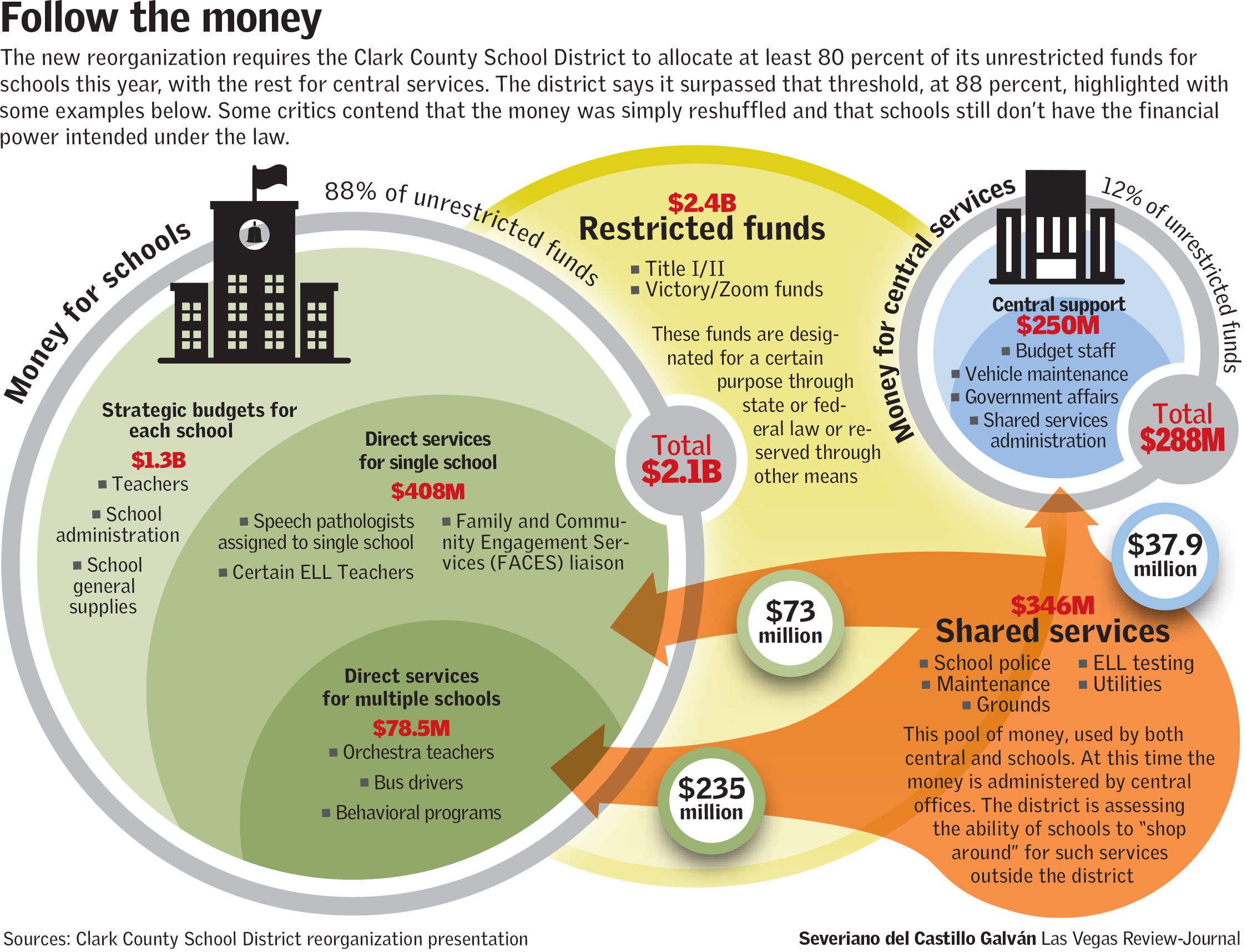Clark County School District overhaul likely to miss deadline

The Clark County School District is expected to be found in violation of state law on Jan. 15 as district officials continue to wrestle with their overhaul of long-standing budget practices to shift more money to schools.
The district will not face penalties or sanctions if, as expected, it is found to be failing to follow the law mandating the reorganization of the nation’s fifth-largest district. Instead state Superintendent of Education Steve Canavero is expected to issue a corrective action plan, with 30-, 60- and 90-day deadlines, to try to get the district on track.
Passed by lawmakers in 2015 and reaffirmed in 2017, the law — commonly referred to by the bill number, AB469 — aims to move budgeting and decision-making to school communities. Provisions in the law require administrators to shift most unrestricted funds into school budgets and away from central operations, with the upcoming deadline being an important milestone.
“At the end of the day, I’m obligated to enforce the law,” Canavero said at a December meeting about the reorganization. “I do not anticipate they will be in compliance” on Jan. 15.
Canavero could find the district in violation of several budgetary provisions of the law, but one issue in particular — known as “attrition savings” — has become a lightning rod for lawmakers overseeing the reorganization.
When school officials can’t find a qualified employee to fill an open position, they can hire a substitute at a lower cost. The difference in cost between the permanent, full-time employee and the sub is called attrition.
Historically, the money has been used to shore up the district’s budget. But under the reorganization, it is supposed to go directly to schools.
No savings this year
“We want those savings to stay with the schools. I want everyone to understand before we leave today,” Sen. Michael Roberson, R-Henderson, chairman of a legislative advisory committee, said at the December meeting.
Roberson said that after a back-and-forth with Clark County schools Superintendent Pat Skorkowsky at the meeting, he thought that schools would receive any attrition savings earned during the 2017-18 year before the beginning of the next school year.
But last week, the district told the Las Vegas Review-Journal that schools wouldn’t receive any attrition savings until after the 2018-19 school year.
“We will do that for the first full budget cycle that occurs after the passage of AB 469, which is the 2018-19 budget,” district spokeswoman Kirsten Searer said.
The 2017-18 year is the first year the district has been required to comply with the law. Although the law was first passed in 2015, the regulations crafted to carry out the reorganization were contested by the school district. The 2017 law, passed with bipartisan support, wrote the contested regulations into the law, fully launching the process.
Roberson said Skorkowsky’s assurances in December led him to believe that the attrition savings would be distributed to schools before the 2018-2019 school year.
“I’d like to say I’m surprised but I’m not,” Roberson said. “They tell the committee one thing when they’re being asked pointed questions on the record but then they don’t follow through.”
But Searer, the district spokeswoman, said Roberson apparently was confused by Skorkowsky’s references to a different reconciliation process that refunds unspent money for supplies and programs to the schools.
“We have said consistently that we are working on a process to provide attrition savings to schools starting with the ’18-19 school year,” she said.

A long slog to compliance
The law mandates that 80 percent of unrestricted funds should be in school budgets, with 20 percent remaining at the central administrative unit, for the first year of the reorganization. The split shifts to 85-15 starting the following year.
Earlier this past year, the district reported it was at an 88-12 split, although only 55 percent of the unrestricted money was in schools budgets.
The district has not yet said where the split will fall for the 2018-19 year, but is expected to set a target at a Jan. 11 meeting.
Although promising progress, Skorkowsky pushed back at lawmakers who accused the district of dragging its feet at the December meeting, saying employees are working “their tail ends off” trying to get the reorganization done.
“We can’t do everything at once, and if we do it poorly then our kids are going to suffer,” he said. “So right now it’s about how do we put systems and structures in place.”
But consultant Glenn Christenson, who chaired a community implementation council on the reorganization, said there are still some district employees who don’t believe the reorganization is real and that it’ll last. Those people, he said, are holding the district back from fulfilling its obligation.
“Despite a lot of progress that we made over the year, not everyone still has bought into the concept of the reorganization, and some continue to still actively undermine it,” he said. “We have to get to a point where the nonbelievers are believers.”
Assemblywoman Dina Neal, D-North Las Vegas, said lawmakers also bear some responsibility for that reluctance to embrace the initiative because they have introduced new education initiatives, pushed them for a few years and then let them fall by the wayside.
“Our biggest problem is we’re never consistent in our behavior, we’re never consistent in our policies,” she said. “We do 15 different experiments, there’s 25 to 30 different things we’ve forced teachers and this organization to do but without fidelity.”
But other lawmakers point to the Board of Trustees, who voted against a pilot proposal in November that would allow a small subset of schools to hire outside contractors for custodial services — a test of school-level decision-making.
Instead, schools will have custodial dollars in their 2018-19 budgets but will not be able to hire outside the district for those services, which critics say goes against the intent of the law.
“I just have not seen a lot of evidence we’ve seen progress around that,” said John Vellardita, head of the teacher’s union. “The (custodial) money was transferred to schools but same central model in place. Nothing got done.”
Trustee Kevin Child said the board did not want to outsource jobs and run the risk of adversely affecting district employees.
“The law doesn’t say we have to outsource,” he said. “(It says) return the money to the school so they make the decision.”
Contact Meghin Delaney at 702-383-0281 or mdelaney@reviewjournal.com. Follow @MeghinDelaney on Twitter.
Related
Education chief wants new Clark County schools reorg consultant
School board moves funds for custodians, IT to schools’ individual budgets
Clark County principals, in survey, say they want more control
‘Reorganized’ Clark County schools prepare for new year
Panel unanimously approves Clark County School District breakup plan
‘Attrition savings’ explained
A recent letter from the Stanford Elementary School organizational team provides a window into how the “attrition savings” reimbursement will work. The school requested $100,000 in attrition savings because it has two vacancies being filled with substitutes (in the mistaken belief that the payments would start this year).
An average teacher costs $80,000 a year, according to the school’s letter, signed at its Dec. 19 meeting. A substitute makes $150 a day, for 184 work days, that’s $28,000, leaving a difference of more than $50,000.
“The reorganization language states the money needs to be pushed to the schools. We are only requesting what the law says that we are entitled to have,” the letter from Stanford Elementary states. “We are a Title 1, Tier 1 school and we could really use those resources.”













